Knowledge Exchange Project: Improving HR Functions at Co-op Food UK
VerifiedAdded on 2022/12/23
|29
|6872
|45
Project
AI Summary
This project is a comprehensive analysis of the HR department within Co-op Food UK, examining its functions, challenges, and potential improvements. The project begins with an introduction outlining the identified issues, followed by the project background, business case, and a cost-benefit analysis. A thorough literature review explores the roles of HR, challenges faced, and methods for improvement. The project defines clear research objectives and a rationale for the study, detailing the methodology, including the research philosophy and sample. It presents a timeline, acknowledges limitations, and covers project planning and resource allocation. The project then discusses the results and findings, assessing whether the objectives were achieved, and evaluates the impact on the business along with a sustainability plan. Finally, it includes a reflection on the impact of the experience on the student's skills and employability, and concludes with a list of references.
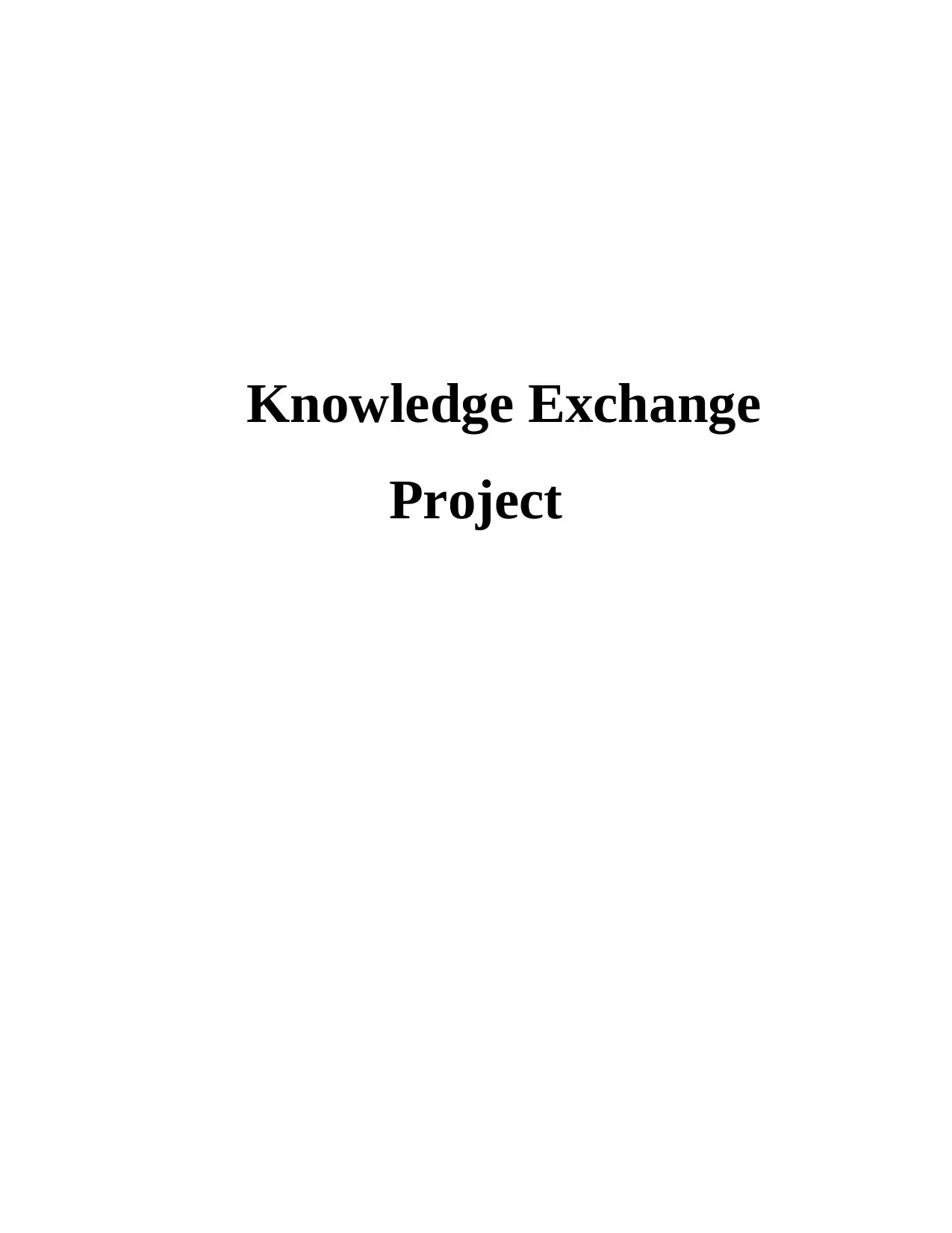
Knowledge Exchange
Project
Project
Paraphrase This Document
Need a fresh take? Get an instant paraphrase of this document with our AI Paraphraser
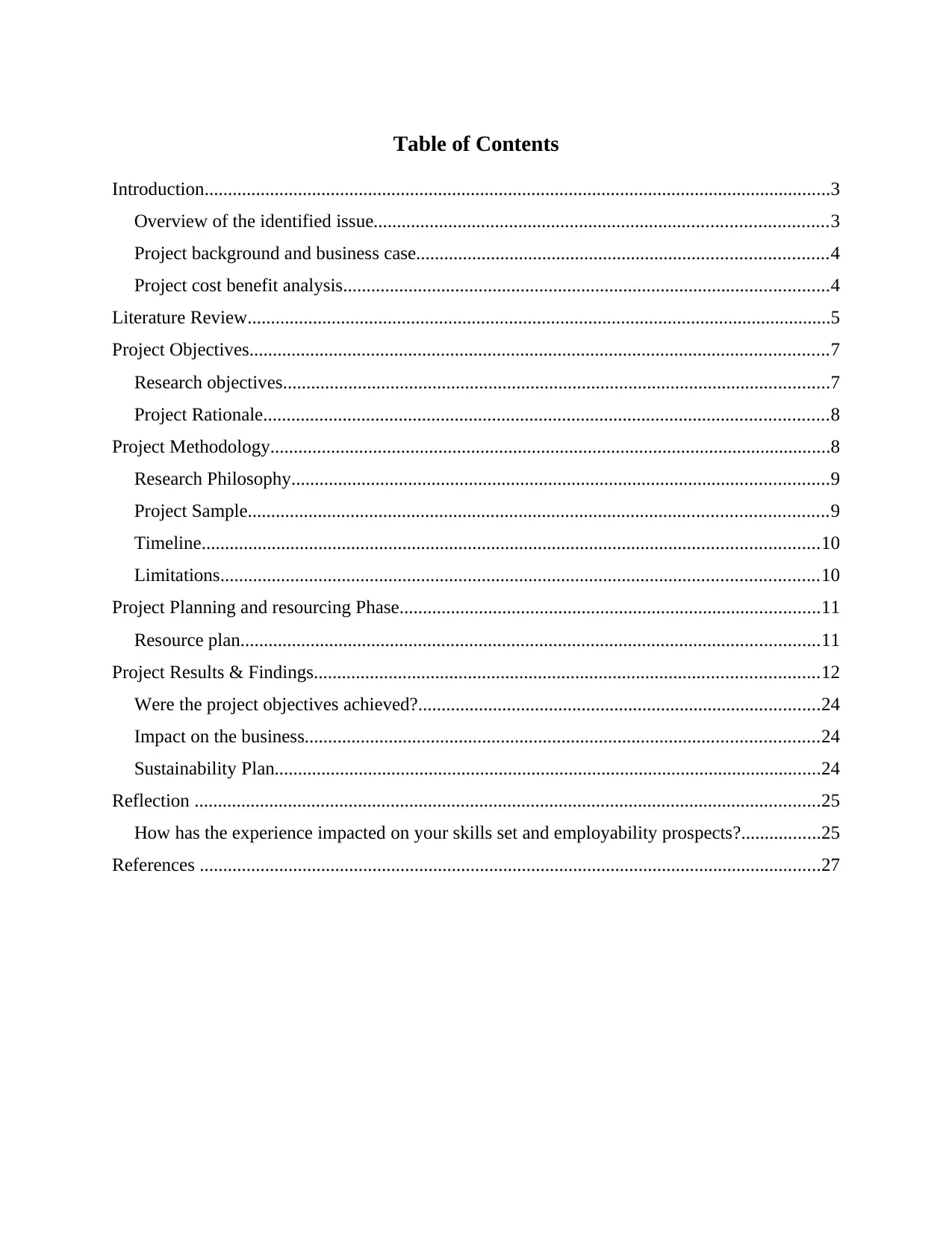
Table of Contents
Introduction......................................................................................................................................3
Overview of the identified issue.................................................................................................3
Project background and business case........................................................................................4
Project cost benefit analysis........................................................................................................4
Literature Review.............................................................................................................................5
Project Objectives............................................................................................................................7
Research objectives.....................................................................................................................7
Project Rationale.........................................................................................................................8
Project Methodology........................................................................................................................8
Research Philosophy...................................................................................................................9
Project Sample............................................................................................................................9
Timeline....................................................................................................................................10
Limitations................................................................................................................................10
Project Planning and resourcing Phase..........................................................................................11
Resource plan............................................................................................................................11
Project Results & Findings............................................................................................................12
Were the project objectives achieved?......................................................................................24
Impact on the business..............................................................................................................24
Sustainability Plan.....................................................................................................................24
Reflection ......................................................................................................................................25
How has the experience impacted on your skills set and employability prospects?.................25
References .....................................................................................................................................27
Introduction......................................................................................................................................3
Overview of the identified issue.................................................................................................3
Project background and business case........................................................................................4
Project cost benefit analysis........................................................................................................4
Literature Review.............................................................................................................................5
Project Objectives............................................................................................................................7
Research objectives.....................................................................................................................7
Project Rationale.........................................................................................................................8
Project Methodology........................................................................................................................8
Research Philosophy...................................................................................................................9
Project Sample............................................................................................................................9
Timeline....................................................................................................................................10
Limitations................................................................................................................................10
Project Planning and resourcing Phase..........................................................................................11
Resource plan............................................................................................................................11
Project Results & Findings............................................................................................................12
Were the project objectives achieved?......................................................................................24
Impact on the business..............................................................................................................24
Sustainability Plan.....................................................................................................................24
Reflection ......................................................................................................................................25
How has the experience impacted on your skills set and employability prospects?.................25
References .....................................................................................................................................27
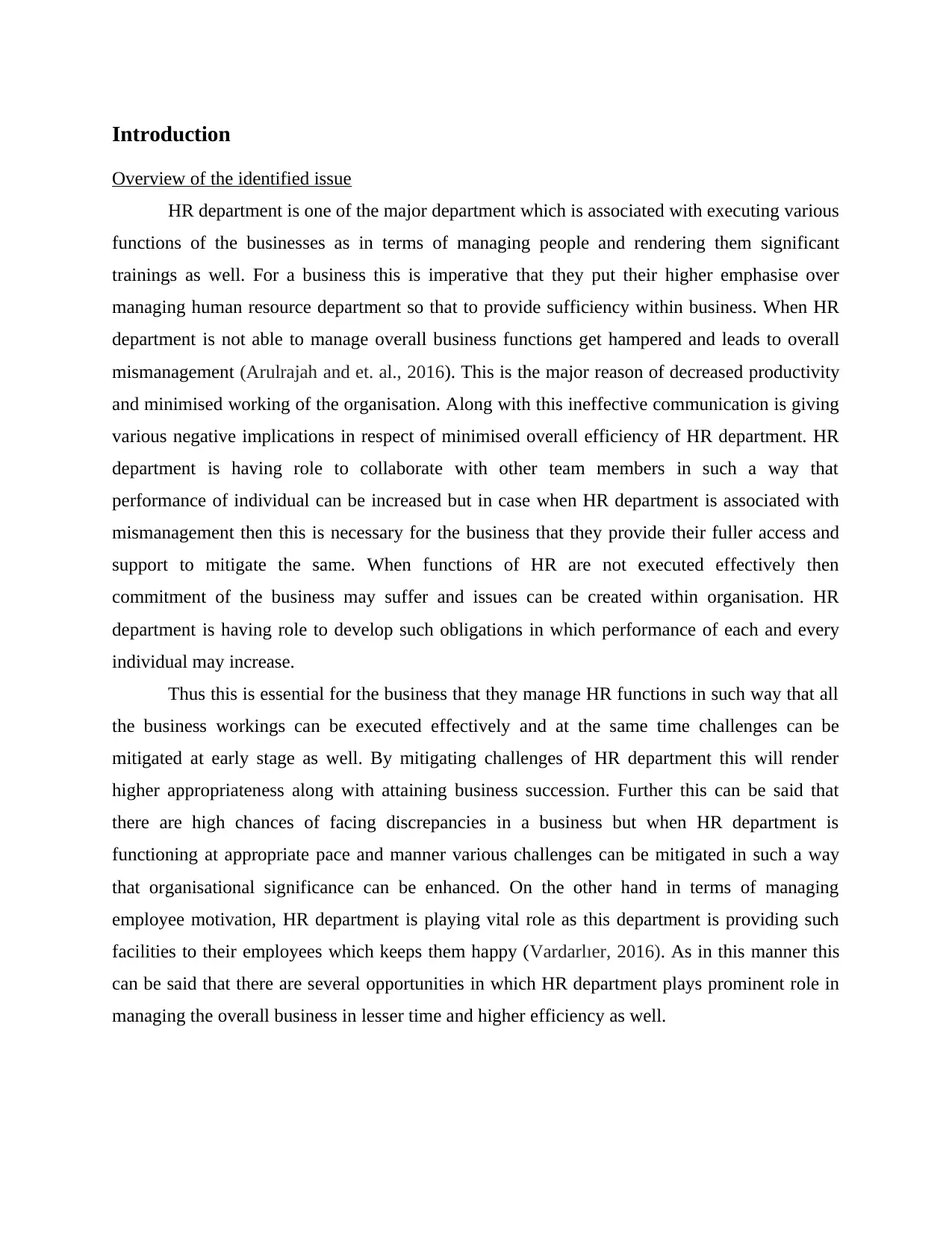
Introduction
Overview of the identified issue
HR department is one of the major department which is associated with executing various
functions of the businesses as in terms of managing people and rendering them significant
trainings as well. For a business this is imperative that they put their higher emphasise over
managing human resource department so that to provide sufficiency within business. When HR
department is not able to manage overall business functions get hampered and leads to overall
mismanagement (Arulrajah and et. al., 2016). This is the major reason of decreased productivity
and minimised working of the organisation. Along with this ineffective communication is giving
various negative implications in respect of minimised overall efficiency of HR department. HR
department is having role to collaborate with other team members in such a way that
performance of individual can be increased but in case when HR department is associated with
mismanagement then this is necessary for the business that they provide their fuller access and
support to mitigate the same. When functions of HR are not executed effectively then
commitment of the business may suffer and issues can be created within organisation. HR
department is having role to develop such obligations in which performance of each and every
individual may increase.
Thus this is essential for the business that they manage HR functions in such way that all
the business workings can be executed effectively and at the same time challenges can be
mitigated at early stage as well. By mitigating challenges of HR department this will render
higher appropriateness along with attaining business succession. Further this can be said that
there are high chances of facing discrepancies in a business but when HR department is
functioning at appropriate pace and manner various challenges can be mitigated in such a way
that organisational significance can be enhanced. On the other hand in terms of managing
employee motivation, HR department is playing vital role as this department is providing such
facilities to their employees which keeps them happy (Vardarlıer, 2016). As in this manner this
can be said that there are several opportunities in which HR department plays prominent role in
managing the overall business in lesser time and higher efficiency as well.
Overview of the identified issue
HR department is one of the major department which is associated with executing various
functions of the businesses as in terms of managing people and rendering them significant
trainings as well. For a business this is imperative that they put their higher emphasise over
managing human resource department so that to provide sufficiency within business. When HR
department is not able to manage overall business functions get hampered and leads to overall
mismanagement (Arulrajah and et. al., 2016). This is the major reason of decreased productivity
and minimised working of the organisation. Along with this ineffective communication is giving
various negative implications in respect of minimised overall efficiency of HR department. HR
department is having role to collaborate with other team members in such a way that
performance of individual can be increased but in case when HR department is associated with
mismanagement then this is necessary for the business that they provide their fuller access and
support to mitigate the same. When functions of HR are not executed effectively then
commitment of the business may suffer and issues can be created within organisation. HR
department is having role to develop such obligations in which performance of each and every
individual may increase.
Thus this is essential for the business that they manage HR functions in such way that all
the business workings can be executed effectively and at the same time challenges can be
mitigated at early stage as well. By mitigating challenges of HR department this will render
higher appropriateness along with attaining business succession. Further this can be said that
there are high chances of facing discrepancies in a business but when HR department is
functioning at appropriate pace and manner various challenges can be mitigated in such a way
that organisational significance can be enhanced. On the other hand in terms of managing
employee motivation, HR department is playing vital role as this department is providing such
facilities to their employees which keeps them happy (Vardarlıer, 2016). As in this manner this
can be said that there are several opportunities in which HR department plays prominent role in
managing the overall business in lesser time and higher efficiency as well.
⊘ This is a preview!⊘
Do you want full access?
Subscribe today to unlock all pages.

Trusted by 1+ million students worldwide
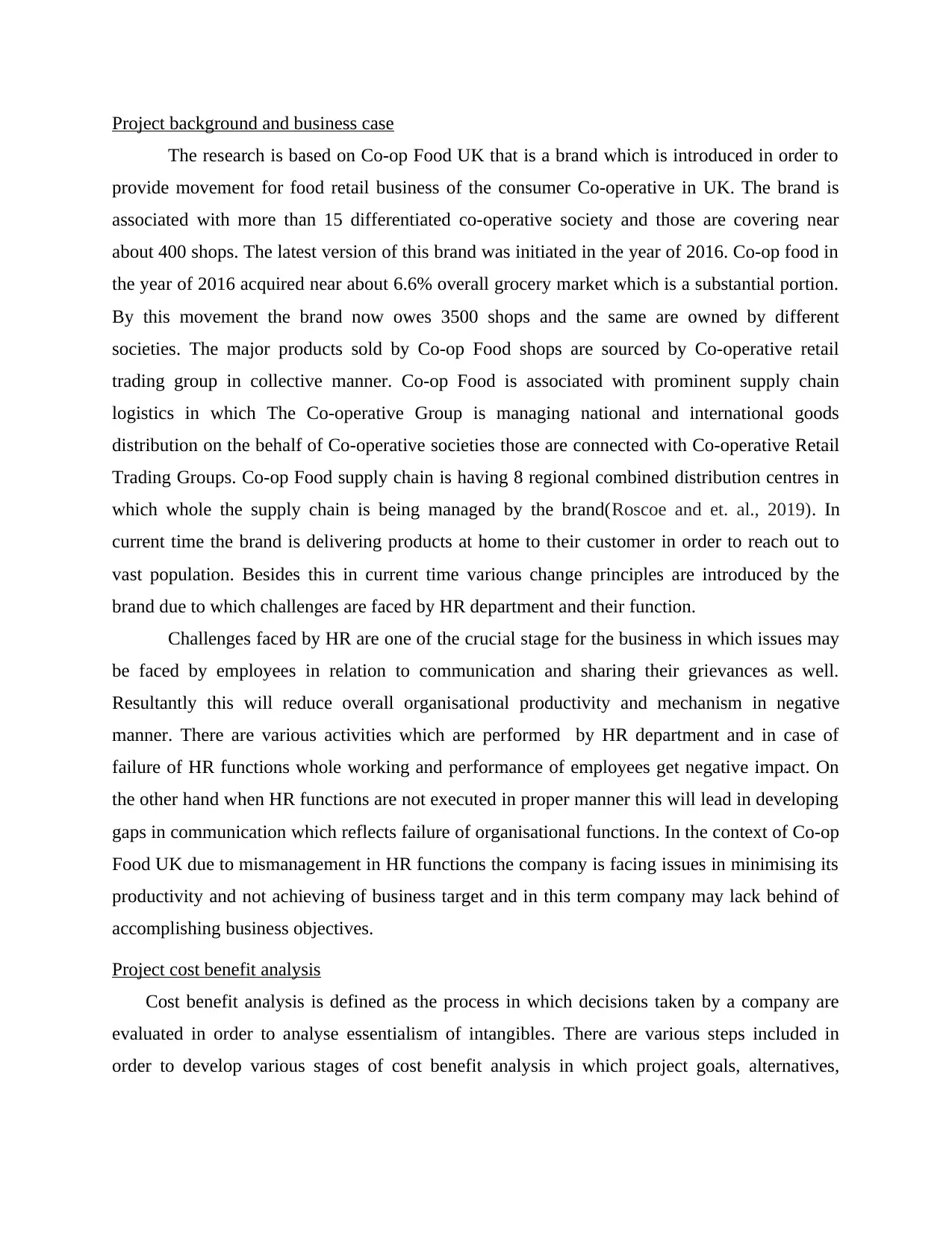
Project background and business case
The research is based on Co-op Food UK that is a brand which is introduced in order to
provide movement for food retail business of the consumer Co-operative in UK. The brand is
associated with more than 15 differentiated co-operative society and those are covering near
about 400 shops. The latest version of this brand was initiated in the year of 2016. Co-op food in
the year of 2016 acquired near about 6.6% overall grocery market which is a substantial portion.
By this movement the brand now owes 3500 shops and the same are owned by different
societies. The major products sold by Co-op Food shops are sourced by Co-operative retail
trading group in collective manner. Co-op Food is associated with prominent supply chain
logistics in which The Co-operative Group is managing national and international goods
distribution on the behalf of Co-operative societies those are connected with Co-operative Retail
Trading Groups. Co-op Food supply chain is having 8 regional combined distribution centres in
which whole the supply chain is being managed by the brand(Roscoe and et. al., 2019). In
current time the brand is delivering products at home to their customer in order to reach out to
vast population. Besides this in current time various change principles are introduced by the
brand due to which challenges are faced by HR department and their function.
Challenges faced by HR are one of the crucial stage for the business in which issues may
be faced by employees in relation to communication and sharing their grievances as well.
Resultantly this will reduce overall organisational productivity and mechanism in negative
manner. There are various activities which are performed by HR department and in case of
failure of HR functions whole working and performance of employees get negative impact. On
the other hand when HR functions are not executed in proper manner this will lead in developing
gaps in communication which reflects failure of organisational functions. In the context of Co-op
Food UK due to mismanagement in HR functions the company is facing issues in minimising its
productivity and not achieving of business target and in this term company may lack behind of
accomplishing business objectives.
Project cost benefit analysis
Cost benefit analysis is defined as the process in which decisions taken by a company are
evaluated in order to analyse essentialism of intangibles. There are various steps included in
order to develop various stages of cost benefit analysis in which project goals, alternatives,
The research is based on Co-op Food UK that is a brand which is introduced in order to
provide movement for food retail business of the consumer Co-operative in UK. The brand is
associated with more than 15 differentiated co-operative society and those are covering near
about 400 shops. The latest version of this brand was initiated in the year of 2016. Co-op food in
the year of 2016 acquired near about 6.6% overall grocery market which is a substantial portion.
By this movement the brand now owes 3500 shops and the same are owned by different
societies. The major products sold by Co-op Food shops are sourced by Co-operative retail
trading group in collective manner. Co-op Food is associated with prominent supply chain
logistics in which The Co-operative Group is managing national and international goods
distribution on the behalf of Co-operative societies those are connected with Co-operative Retail
Trading Groups. Co-op Food supply chain is having 8 regional combined distribution centres in
which whole the supply chain is being managed by the brand(Roscoe and et. al., 2019). In
current time the brand is delivering products at home to their customer in order to reach out to
vast population. Besides this in current time various change principles are introduced by the
brand due to which challenges are faced by HR department and their function.
Challenges faced by HR are one of the crucial stage for the business in which issues may
be faced by employees in relation to communication and sharing their grievances as well.
Resultantly this will reduce overall organisational productivity and mechanism in negative
manner. There are various activities which are performed by HR department and in case of
failure of HR functions whole working and performance of employees get negative impact. On
the other hand when HR functions are not executed in proper manner this will lead in developing
gaps in communication which reflects failure of organisational functions. In the context of Co-op
Food UK due to mismanagement in HR functions the company is facing issues in minimising its
productivity and not achieving of business target and in this term company may lack behind of
accomplishing business objectives.
Project cost benefit analysis
Cost benefit analysis is defined as the process in which decisions taken by a company are
evaluated in order to analyse essentialism of intangibles. There are various steps included in
order to develop various stages of cost benefit analysis in which project goals, alternatives,
Paraphrase This Document
Need a fresh take? Get an instant paraphrase of this document with our AI Paraphraser
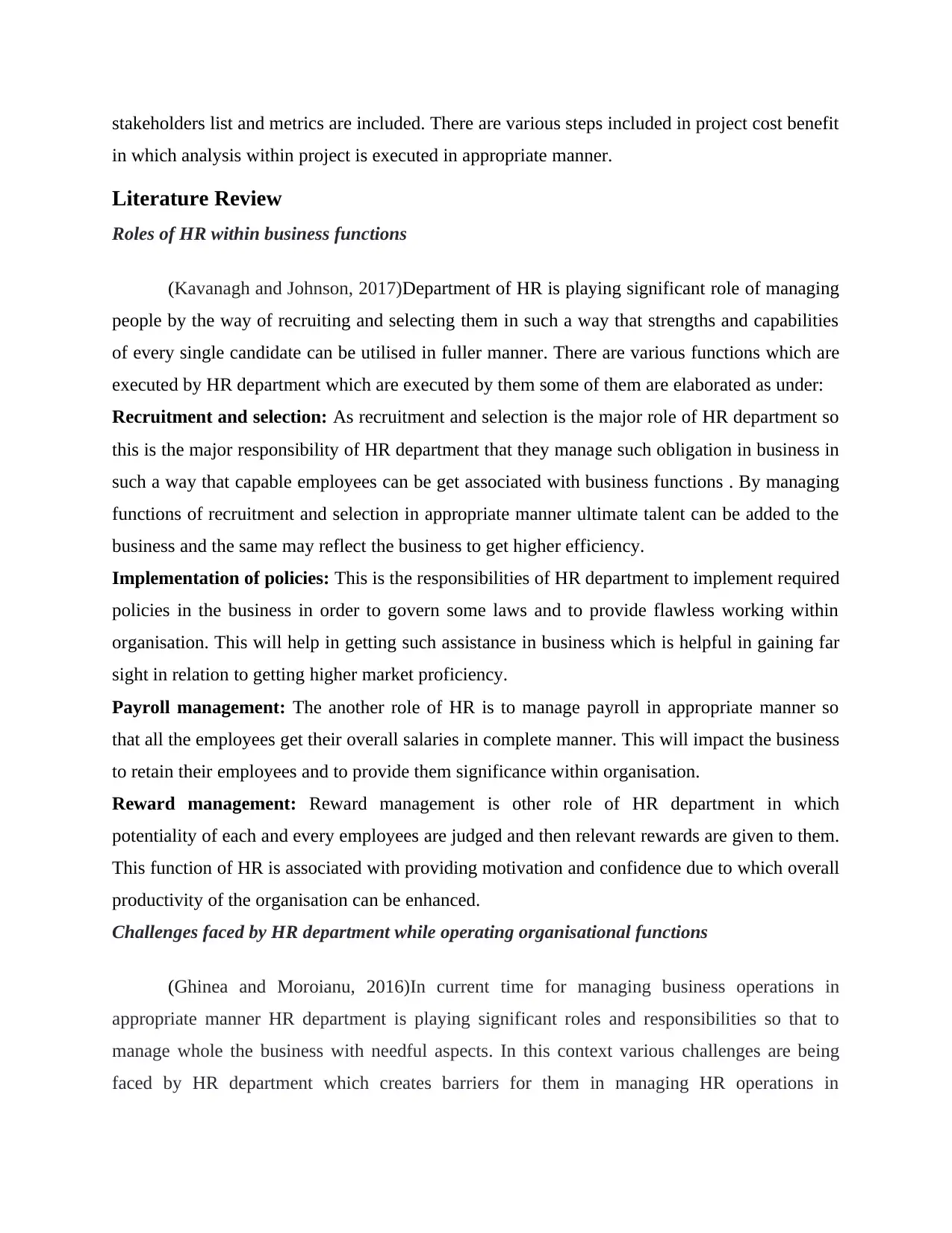
stakeholders list and metrics are included. There are various steps included in project cost benefit
in which analysis within project is executed in appropriate manner.
Literature Review
Roles of HR within business functions
(Kavanagh and Johnson, 2017)Department of HR is playing significant role of managing
people by the way of recruiting and selecting them in such a way that strengths and capabilities
of every single candidate can be utilised in fuller manner. There are various functions which are
executed by HR department which are executed by them some of them are elaborated as under:
Recruitment and selection: As recruitment and selection is the major role of HR department so
this is the major responsibility of HR department that they manage such obligation in business in
such a way that capable employees can be get associated with business functions . By managing
functions of recruitment and selection in appropriate manner ultimate talent can be added to the
business and the same may reflect the business to get higher efficiency.
Implementation of policies: This is the responsibilities of HR department to implement required
policies in the business in order to govern some laws and to provide flawless working within
organisation. This will help in getting such assistance in business which is helpful in gaining far
sight in relation to getting higher market proficiency.
Payroll management: The another role of HR is to manage payroll in appropriate manner so
that all the employees get their overall salaries in complete manner. This will impact the business
to retain their employees and to provide them significance within organisation.
Reward management: Reward management is other role of HR department in which
potentiality of each and every employees are judged and then relevant rewards are given to them.
This function of HR is associated with providing motivation and confidence due to which overall
productivity of the organisation can be enhanced.
Challenges faced by HR department while operating organisational functions
(Ghinea and Moroianu, 2016)In current time for managing business operations in
appropriate manner HR department is playing significant roles and responsibilities so that to
manage whole the business with needful aspects. In this context various challenges are being
faced by HR department which creates barriers for them in managing HR operations in
in which analysis within project is executed in appropriate manner.
Literature Review
Roles of HR within business functions
(Kavanagh and Johnson, 2017)Department of HR is playing significant role of managing
people by the way of recruiting and selecting them in such a way that strengths and capabilities
of every single candidate can be utilised in fuller manner. There are various functions which are
executed by HR department which are executed by them some of them are elaborated as under:
Recruitment and selection: As recruitment and selection is the major role of HR department so
this is the major responsibility of HR department that they manage such obligation in business in
such a way that capable employees can be get associated with business functions . By managing
functions of recruitment and selection in appropriate manner ultimate talent can be added to the
business and the same may reflect the business to get higher efficiency.
Implementation of policies: This is the responsibilities of HR department to implement required
policies in the business in order to govern some laws and to provide flawless working within
organisation. This will help in getting such assistance in business which is helpful in gaining far
sight in relation to getting higher market proficiency.
Payroll management: The another role of HR is to manage payroll in appropriate manner so
that all the employees get their overall salaries in complete manner. This will impact the business
to retain their employees and to provide them significance within organisation.
Reward management: Reward management is other role of HR department in which
potentiality of each and every employees are judged and then relevant rewards are given to them.
This function of HR is associated with providing motivation and confidence due to which overall
productivity of the organisation can be enhanced.
Challenges faced by HR department while operating organisational functions
(Ghinea and Moroianu, 2016)In current time for managing business operations in
appropriate manner HR department is playing significant roles and responsibilities so that to
manage whole the business with needful aspects. In this context various challenges are being
faced by HR department which creates barriers for them in managing HR operations in
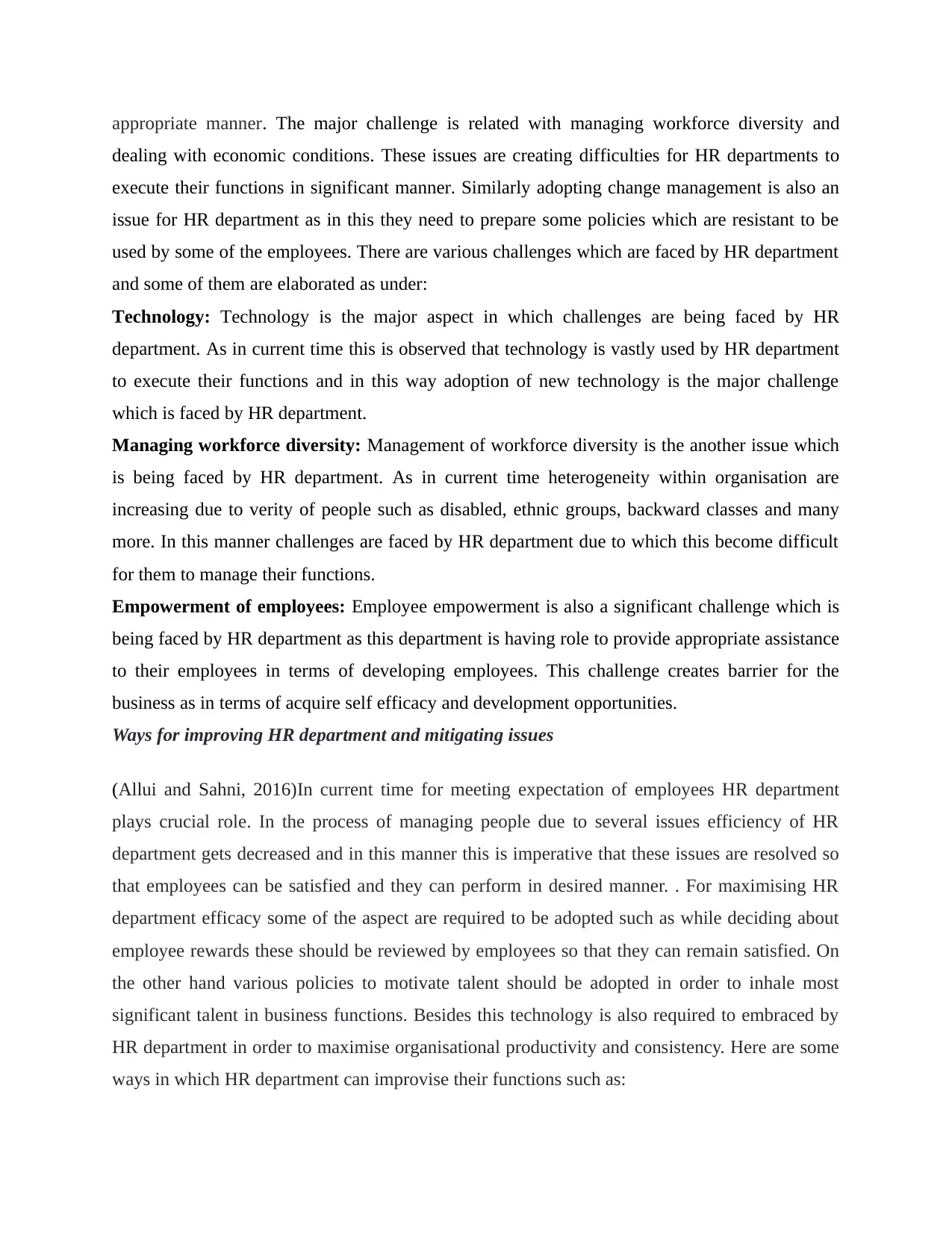
appropriate manner. The major challenge is related with managing workforce diversity and
dealing with economic conditions. These issues are creating difficulties for HR departments to
execute their functions in significant manner. Similarly adopting change management is also an
issue for HR department as in this they need to prepare some policies which are resistant to be
used by some of the employees. There are various challenges which are faced by HR department
and some of them are elaborated as under:
Technology: Technology is the major aspect in which challenges are being faced by HR
department. As in current time this is observed that technology is vastly used by HR department
to execute their functions and in this way adoption of new technology is the major challenge
which is faced by HR department.
Managing workforce diversity: Management of workforce diversity is the another issue which
is being faced by HR department. As in current time heterogeneity within organisation are
increasing due to verity of people such as disabled, ethnic groups, backward classes and many
more. In this manner challenges are faced by HR department due to which this become difficult
for them to manage their functions.
Empowerment of employees: Employee empowerment is also a significant challenge which is
being faced by HR department as this department is having role to provide appropriate assistance
to their employees in terms of developing employees. This challenge creates barrier for the
business as in terms of acquire self efficacy and development opportunities.
Ways for improving HR department and mitigating issues
(Allui and Sahni, 2016)In current time for meeting expectation of employees HR department
plays crucial role. In the process of managing people due to several issues efficiency of HR
department gets decreased and in this manner this is imperative that these issues are resolved so
that employees can be satisfied and they can perform in desired manner. . For maximising HR
department efficacy some of the aspect are required to be adopted such as while deciding about
employee rewards these should be reviewed by employees so that they can remain satisfied. On
the other hand various policies to motivate talent should be adopted in order to inhale most
significant talent in business functions. Besides this technology is also required to embraced by
HR department in order to maximise organisational productivity and consistency. Here are some
ways in which HR department can improvise their functions such as:
dealing with economic conditions. These issues are creating difficulties for HR departments to
execute their functions in significant manner. Similarly adopting change management is also an
issue for HR department as in this they need to prepare some policies which are resistant to be
used by some of the employees. There are various challenges which are faced by HR department
and some of them are elaborated as under:
Technology: Technology is the major aspect in which challenges are being faced by HR
department. As in current time this is observed that technology is vastly used by HR department
to execute their functions and in this way adoption of new technology is the major challenge
which is faced by HR department.
Managing workforce diversity: Management of workforce diversity is the another issue which
is being faced by HR department. As in current time heterogeneity within organisation are
increasing due to verity of people such as disabled, ethnic groups, backward classes and many
more. In this manner challenges are faced by HR department due to which this become difficult
for them to manage their functions.
Empowerment of employees: Employee empowerment is also a significant challenge which is
being faced by HR department as this department is having role to provide appropriate assistance
to their employees in terms of developing employees. This challenge creates barrier for the
business as in terms of acquire self efficacy and development opportunities.
Ways for improving HR department and mitigating issues
(Allui and Sahni, 2016)In current time for meeting expectation of employees HR department
plays crucial role. In the process of managing people due to several issues efficiency of HR
department gets decreased and in this manner this is imperative that these issues are resolved so
that employees can be satisfied and they can perform in desired manner. . For maximising HR
department efficacy some of the aspect are required to be adopted such as while deciding about
employee rewards these should be reviewed by employees so that they can remain satisfied. On
the other hand various policies to motivate talent should be adopted in order to inhale most
significant talent in business functions. Besides this technology is also required to embraced by
HR department in order to maximise organisational productivity and consistency. Here are some
ways in which HR department can improvise their functions such as:
⊘ This is a preview!⊘
Do you want full access?
Subscribe today to unlock all pages.

Trusted by 1+ million students worldwide
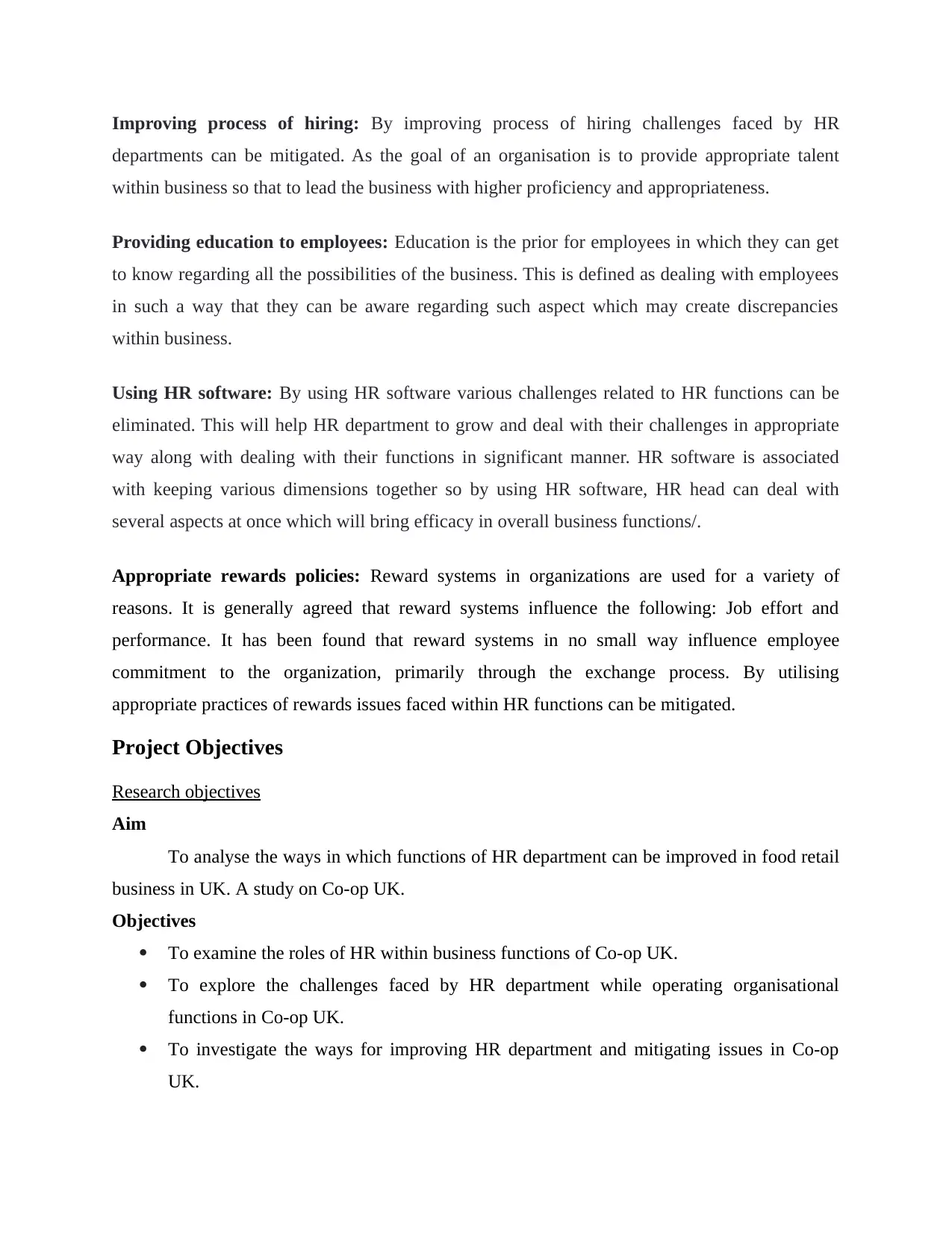
Improving process of hiring: By improving process of hiring challenges faced by HR
departments can be mitigated. As the goal of an organisation is to provide appropriate talent
within business so that to lead the business with higher proficiency and appropriateness.
Providing education to employees: Education is the prior for employees in which they can get
to know regarding all the possibilities of the business. This is defined as dealing with employees
in such a way that they can be aware regarding such aspect which may create discrepancies
within business.
Using HR software: By using HR software various challenges related to HR functions can be
eliminated. This will help HR department to grow and deal with their challenges in appropriate
way along with dealing with their functions in significant manner. HR software is associated
with keeping various dimensions together so by using HR software, HR head can deal with
several aspects at once which will bring efficacy in overall business functions/.
Appropriate rewards policies: Reward systems in organizations are used for a variety of
reasons. It is generally agreed that reward systems influence the following: Job effort and
performance. It has been found that reward systems in no small way influence employee
commitment to the organization, primarily through the exchange process. By utilising
appropriate practices of rewards issues faced within HR functions can be mitigated.
Project Objectives
Research objectives
Aim
To analyse the ways in which functions of HR department can be improved in food retail
business in UK. A study on Co-op UK.
Objectives
To examine the roles of HR within business functions of Co-op UK.
To explore the challenges faced by HR department while operating organisational
functions in Co-op UK.
To investigate the ways for improving HR department and mitigating issues in Co-op
UK.
departments can be mitigated. As the goal of an organisation is to provide appropriate talent
within business so that to lead the business with higher proficiency and appropriateness.
Providing education to employees: Education is the prior for employees in which they can get
to know regarding all the possibilities of the business. This is defined as dealing with employees
in such a way that they can be aware regarding such aspect which may create discrepancies
within business.
Using HR software: By using HR software various challenges related to HR functions can be
eliminated. This will help HR department to grow and deal with their challenges in appropriate
way along with dealing with their functions in significant manner. HR software is associated
with keeping various dimensions together so by using HR software, HR head can deal with
several aspects at once which will bring efficacy in overall business functions/.
Appropriate rewards policies: Reward systems in organizations are used for a variety of
reasons. It is generally agreed that reward systems influence the following: Job effort and
performance. It has been found that reward systems in no small way influence employee
commitment to the organization, primarily through the exchange process. By utilising
appropriate practices of rewards issues faced within HR functions can be mitigated.
Project Objectives
Research objectives
Aim
To analyse the ways in which functions of HR department can be improved in food retail
business in UK. A study on Co-op UK.
Objectives
To examine the roles of HR within business functions of Co-op UK.
To explore the challenges faced by HR department while operating organisational
functions in Co-op UK.
To investigate the ways for improving HR department and mitigating issues in Co-op
UK.
Paraphrase This Document
Need a fresh take? Get an instant paraphrase of this document with our AI Paraphraser
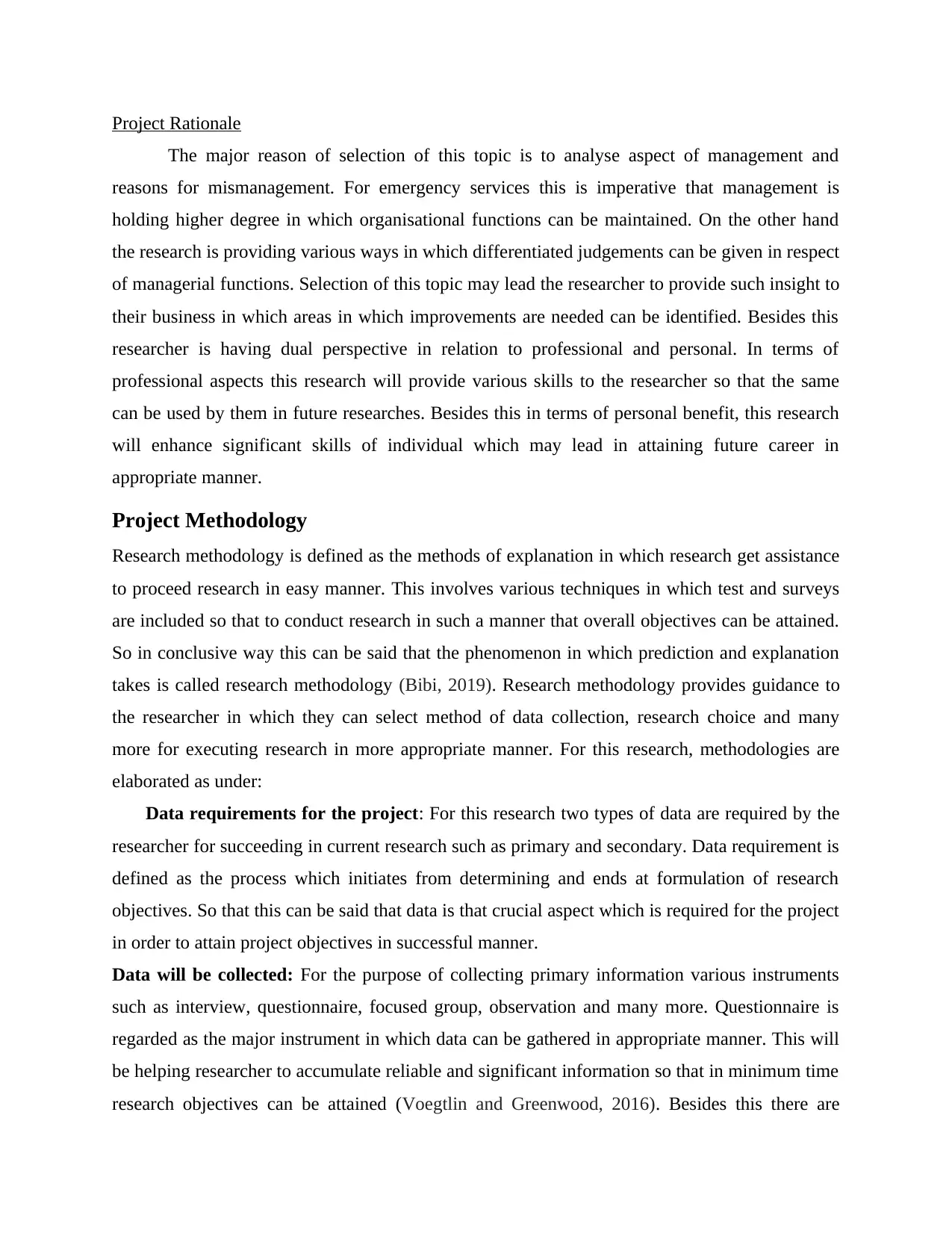
Project Rationale
The major reason of selection of this topic is to analyse aspect of management and
reasons for mismanagement. For emergency services this is imperative that management is
holding higher degree in which organisational functions can be maintained. On the other hand
the research is providing various ways in which differentiated judgements can be given in respect
of managerial functions. Selection of this topic may lead the researcher to provide such insight to
their business in which areas in which improvements are needed can be identified. Besides this
researcher is having dual perspective in relation to professional and personal. In terms of
professional aspects this research will provide various skills to the researcher so that the same
can be used by them in future researches. Besides this in terms of personal benefit, this research
will enhance significant skills of individual which may lead in attaining future career in
appropriate manner.
Project Methodology
Research methodology is defined as the methods of explanation in which research get assistance
to proceed research in easy manner. This involves various techniques in which test and surveys
are included so that to conduct research in such a manner that overall objectives can be attained.
So in conclusive way this can be said that the phenomenon in which prediction and explanation
takes is called research methodology (Bibi, 2019). Research methodology provides guidance to
the researcher in which they can select method of data collection, research choice and many
more for executing research in more appropriate manner. For this research, methodologies are
elaborated as under:
Data requirements for the project: For this research two types of data are required by the
researcher for succeeding in current research such as primary and secondary. Data requirement is
defined as the process which initiates from determining and ends at formulation of research
objectives. So that this can be said that data is that crucial aspect which is required for the project
in order to attain project objectives in successful manner.
Data will be collected: For the purpose of collecting primary information various instruments
such as interview, questionnaire, focused group, observation and many more. Questionnaire is
regarded as the major instrument in which data can be gathered in appropriate manner. This will
be helping researcher to accumulate reliable and significant information so that in minimum time
research objectives can be attained (Voegtlin and Greenwood, 2016). Besides this there are
The major reason of selection of this topic is to analyse aspect of management and
reasons for mismanagement. For emergency services this is imperative that management is
holding higher degree in which organisational functions can be maintained. On the other hand
the research is providing various ways in which differentiated judgements can be given in respect
of managerial functions. Selection of this topic may lead the researcher to provide such insight to
their business in which areas in which improvements are needed can be identified. Besides this
researcher is having dual perspective in relation to professional and personal. In terms of
professional aspects this research will provide various skills to the researcher so that the same
can be used by them in future researches. Besides this in terms of personal benefit, this research
will enhance significant skills of individual which may lead in attaining future career in
appropriate manner.
Project Methodology
Research methodology is defined as the methods of explanation in which research get assistance
to proceed research in easy manner. This involves various techniques in which test and surveys
are included so that to conduct research in such a manner that overall objectives can be attained.
So in conclusive way this can be said that the phenomenon in which prediction and explanation
takes is called research methodology (Bibi, 2019). Research methodology provides guidance to
the researcher in which they can select method of data collection, research choice and many
more for executing research in more appropriate manner. For this research, methodologies are
elaborated as under:
Data requirements for the project: For this research two types of data are required by the
researcher for succeeding in current research such as primary and secondary. Data requirement is
defined as the process which initiates from determining and ends at formulation of research
objectives. So that this can be said that data is that crucial aspect which is required for the project
in order to attain project objectives in successful manner.
Data will be collected: For the purpose of collecting primary information various instruments
such as interview, questionnaire, focused group, observation and many more. Questionnaire is
regarded as the major instrument in which data can be gathered in appropriate manner. This will
be helping researcher to accumulate reliable and significant information so that in minimum time
research objectives can be attained (Voegtlin and Greenwood, 2016). Besides this there are
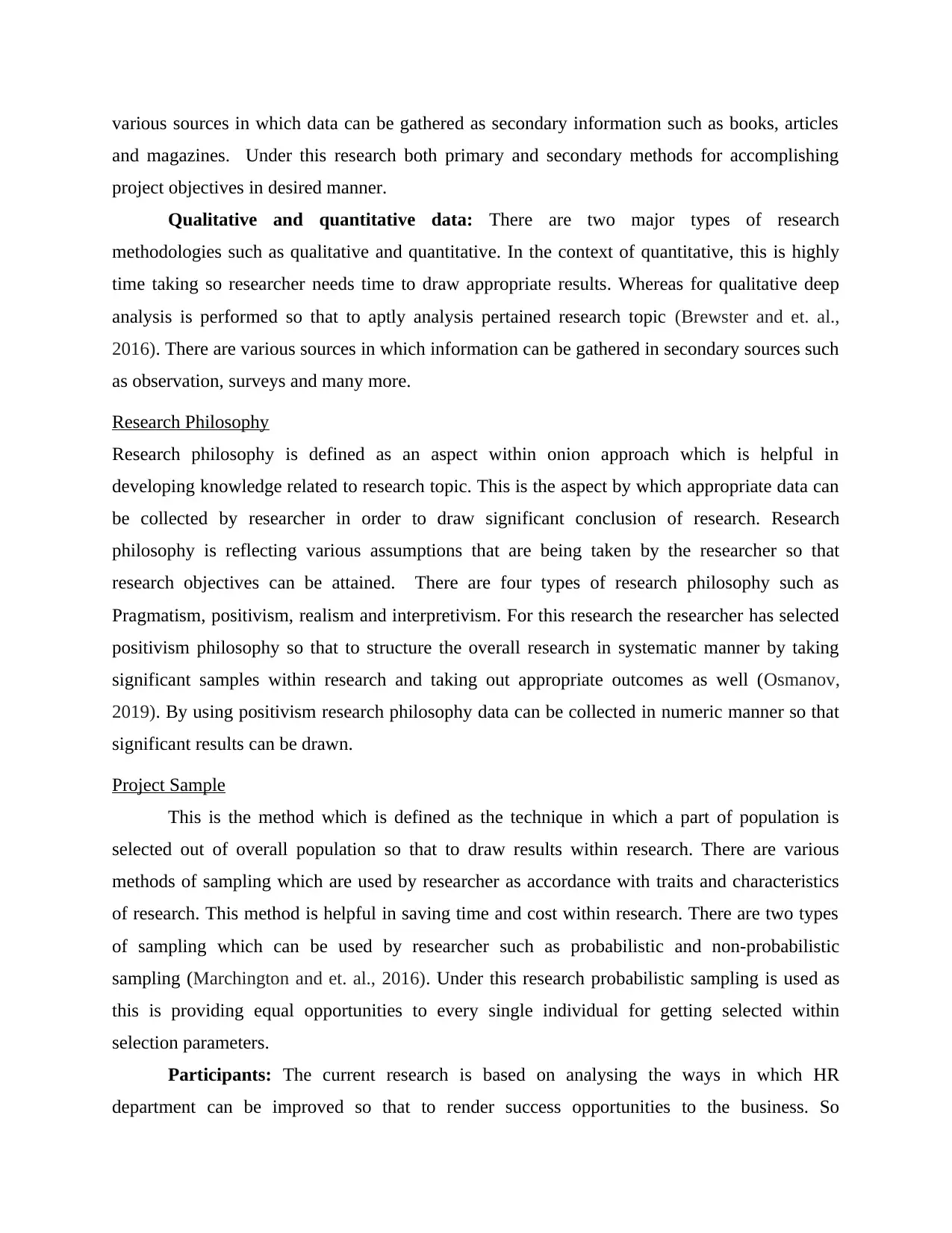
various sources in which data can be gathered as secondary information such as books, articles
and magazines. Under this research both primary and secondary methods for accomplishing
project objectives in desired manner.
Qualitative and quantitative data: There are two major types of research
methodologies such as qualitative and quantitative. In the context of quantitative, this is highly
time taking so researcher needs time to draw appropriate results. Whereas for qualitative deep
analysis is performed so that to aptly analysis pertained research topic (Brewster and et. al.,
2016). There are various sources in which information can be gathered in secondary sources such
as observation, surveys and many more.
Research Philosophy
Research philosophy is defined as an aspect within onion approach which is helpful in
developing knowledge related to research topic. This is the aspect by which appropriate data can
be collected by researcher in order to draw significant conclusion of research. Research
philosophy is reflecting various assumptions that are being taken by the researcher so that
research objectives can be attained. There are four types of research philosophy such as
Pragmatism, positivism, realism and interpretivism. For this research the researcher has selected
positivism philosophy so that to structure the overall research in systematic manner by taking
significant samples within research and taking out appropriate outcomes as well (Osmanov,
2019). By using positivism research philosophy data can be collected in numeric manner so that
significant results can be drawn.
Project Sample
This is the method which is defined as the technique in which a part of population is
selected out of overall population so that to draw results within research. There are various
methods of sampling which are used by researcher as accordance with traits and characteristics
of research. This method is helpful in saving time and cost within research. There are two types
of sampling which can be used by researcher such as probabilistic and non-probabilistic
sampling (Marchington and et. al., 2016). Under this research probabilistic sampling is used as
this is providing equal opportunities to every single individual for getting selected within
selection parameters.
Participants: The current research is based on analysing the ways in which HR
department can be improved so that to render success opportunities to the business. So
and magazines. Under this research both primary and secondary methods for accomplishing
project objectives in desired manner.
Qualitative and quantitative data: There are two major types of research
methodologies such as qualitative and quantitative. In the context of quantitative, this is highly
time taking so researcher needs time to draw appropriate results. Whereas for qualitative deep
analysis is performed so that to aptly analysis pertained research topic (Brewster and et. al.,
2016). There are various sources in which information can be gathered in secondary sources such
as observation, surveys and many more.
Research Philosophy
Research philosophy is defined as an aspect within onion approach which is helpful in
developing knowledge related to research topic. This is the aspect by which appropriate data can
be collected by researcher in order to draw significant conclusion of research. Research
philosophy is reflecting various assumptions that are being taken by the researcher so that
research objectives can be attained. There are four types of research philosophy such as
Pragmatism, positivism, realism and interpretivism. For this research the researcher has selected
positivism philosophy so that to structure the overall research in systematic manner by taking
significant samples within research and taking out appropriate outcomes as well (Osmanov,
2019). By using positivism research philosophy data can be collected in numeric manner so that
significant results can be drawn.
Project Sample
This is the method which is defined as the technique in which a part of population is
selected out of overall population so that to draw results within research. There are various
methods of sampling which are used by researcher as accordance with traits and characteristics
of research. This method is helpful in saving time and cost within research. There are two types
of sampling which can be used by researcher such as probabilistic and non-probabilistic
sampling (Marchington and et. al., 2016). Under this research probabilistic sampling is used as
this is providing equal opportunities to every single individual for getting selected within
selection parameters.
Participants: The current research is based on analysing the ways in which HR
department can be improved so that to render success opportunities to the business. So
⊘ This is a preview!⊘
Do you want full access?
Subscribe today to unlock all pages.

Trusted by 1+ million students worldwide
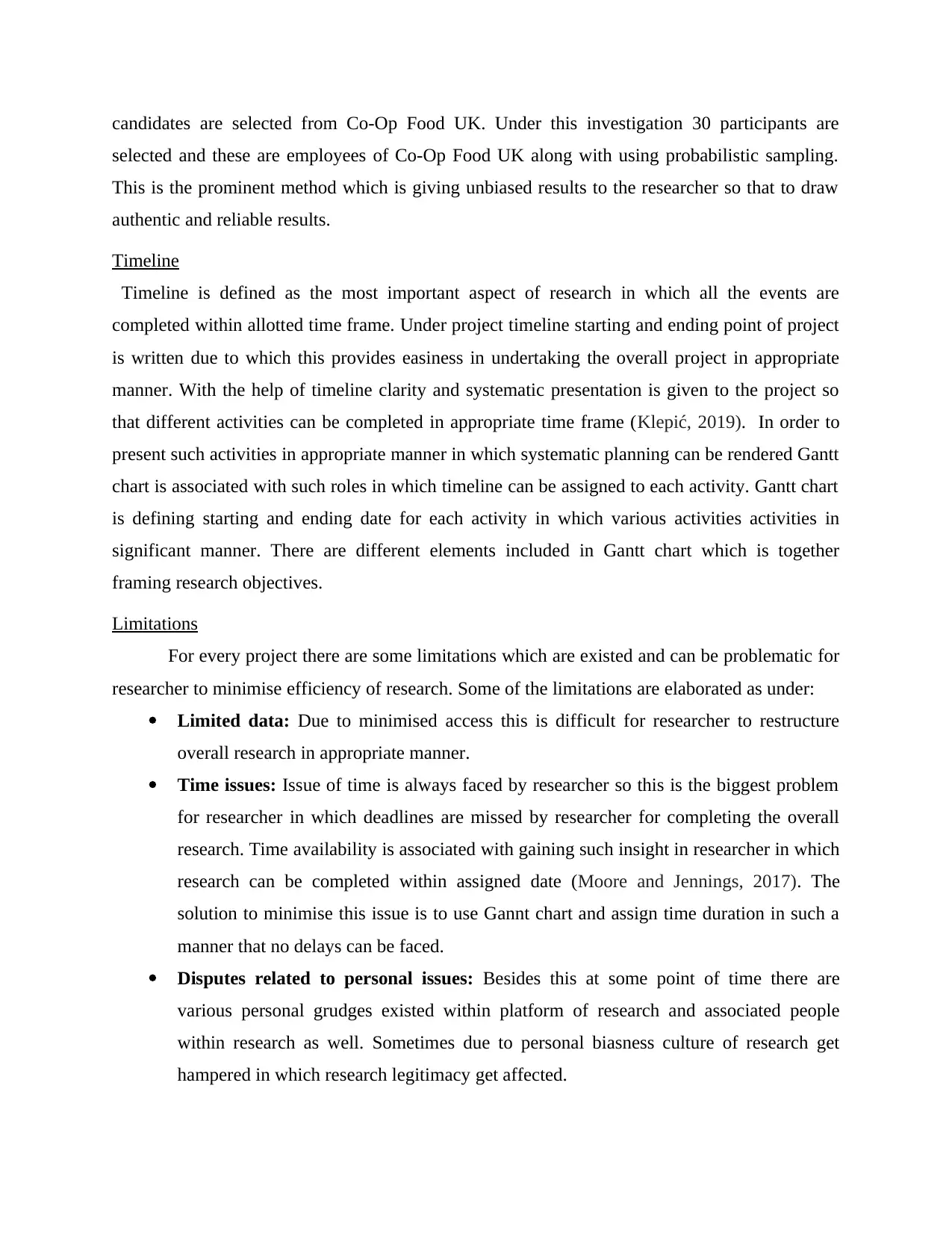
candidates are selected from Co-Op Food UK. Under this investigation 30 participants are
selected and these are employees of Co-Op Food UK along with using probabilistic sampling.
This is the prominent method which is giving unbiased results to the researcher so that to draw
authentic and reliable results.
Timeline
Timeline is defined as the most important aspect of research in which all the events are
completed within allotted time frame. Under project timeline starting and ending point of project
is written due to which this provides easiness in undertaking the overall project in appropriate
manner. With the help of timeline clarity and systematic presentation is given to the project so
that different activities can be completed in appropriate time frame (Klepić, 2019). In order to
present such activities in appropriate manner in which systematic planning can be rendered Gantt
chart is associated with such roles in which timeline can be assigned to each activity. Gantt chart
is defining starting and ending date for each activity in which various activities activities in
significant manner. There are different elements included in Gantt chart which is together
framing research objectives.
Limitations
For every project there are some limitations which are existed and can be problematic for
researcher to minimise efficiency of research. Some of the limitations are elaborated as under:
Limited data: Due to minimised access this is difficult for researcher to restructure
overall research in appropriate manner.
Time issues: Issue of time is always faced by researcher so this is the biggest problem
for researcher in which deadlines are missed by researcher for completing the overall
research. Time availability is associated with gaining such insight in researcher in which
research can be completed within assigned date (Moore and Jennings, 2017). The
solution to minimise this issue is to use Gannt chart and assign time duration in such a
manner that no delays can be faced.
Disputes related to personal issues: Besides this at some point of time there are
various personal grudges existed within platform of research and associated people
within research as well. Sometimes due to personal biasness culture of research get
hampered in which research legitimacy get affected.
selected and these are employees of Co-Op Food UK along with using probabilistic sampling.
This is the prominent method which is giving unbiased results to the researcher so that to draw
authentic and reliable results.
Timeline
Timeline is defined as the most important aspect of research in which all the events are
completed within allotted time frame. Under project timeline starting and ending point of project
is written due to which this provides easiness in undertaking the overall project in appropriate
manner. With the help of timeline clarity and systematic presentation is given to the project so
that different activities can be completed in appropriate time frame (Klepić, 2019). In order to
present such activities in appropriate manner in which systematic planning can be rendered Gantt
chart is associated with such roles in which timeline can be assigned to each activity. Gantt chart
is defining starting and ending date for each activity in which various activities activities in
significant manner. There are different elements included in Gantt chart which is together
framing research objectives.
Limitations
For every project there are some limitations which are existed and can be problematic for
researcher to minimise efficiency of research. Some of the limitations are elaborated as under:
Limited data: Due to minimised access this is difficult for researcher to restructure
overall research in appropriate manner.
Time issues: Issue of time is always faced by researcher so this is the biggest problem
for researcher in which deadlines are missed by researcher for completing the overall
research. Time availability is associated with gaining such insight in researcher in which
research can be completed within assigned date (Moore and Jennings, 2017). The
solution to minimise this issue is to use Gannt chart and assign time duration in such a
manner that no delays can be faced.
Disputes related to personal issues: Besides this at some point of time there are
various personal grudges existed within platform of research and associated people
within research as well. Sometimes due to personal biasness culture of research get
hampered in which research legitimacy get affected.
Paraphrase This Document
Need a fresh take? Get an instant paraphrase of this document with our AI Paraphraser
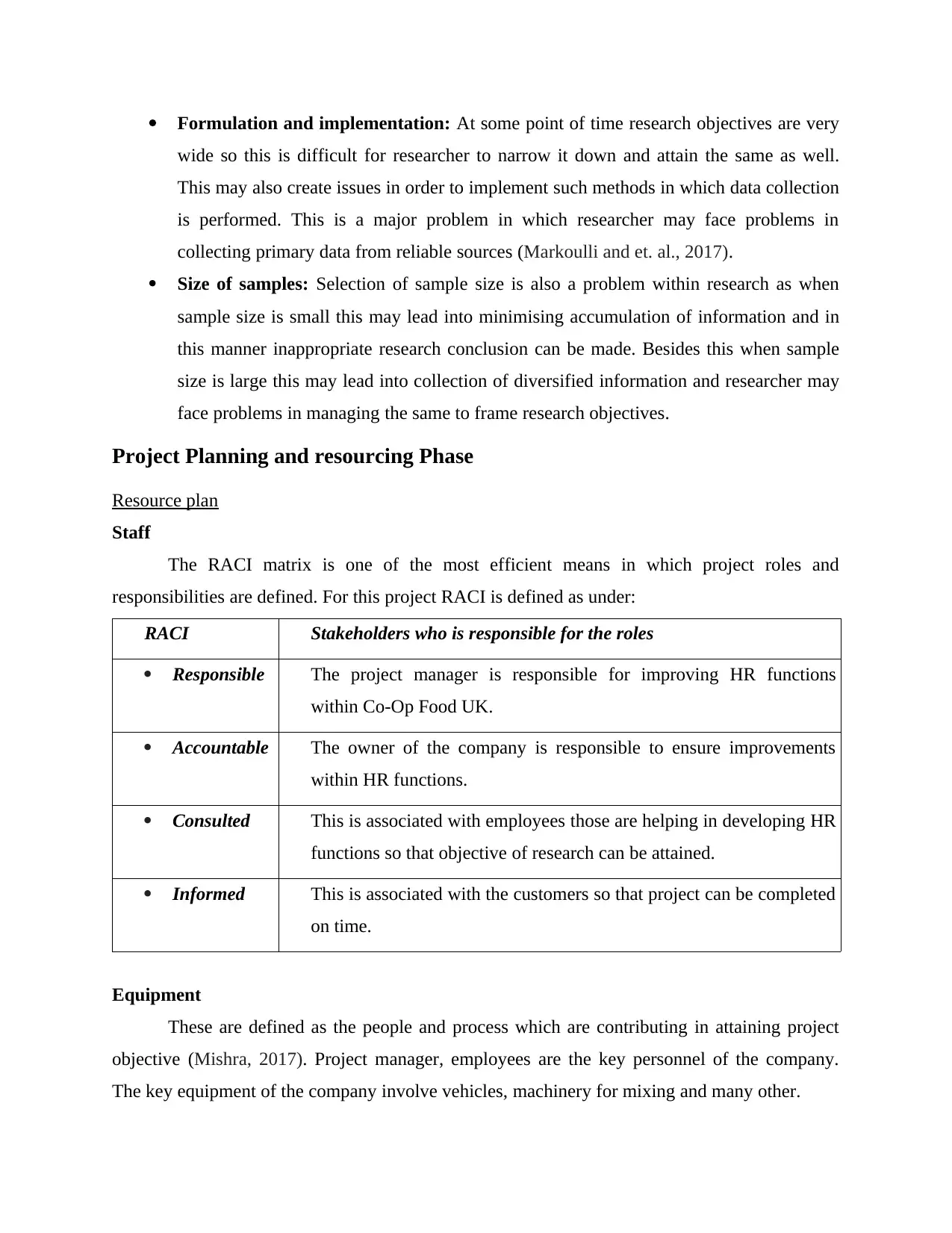
Formulation and implementation: At some point of time research objectives are very
wide so this is difficult for researcher to narrow it down and attain the same as well.
This may also create issues in order to implement such methods in which data collection
is performed. This is a major problem in which researcher may face problems in
collecting primary data from reliable sources (Markoulli and et. al., 2017).
Size of samples: Selection of sample size is also a problem within research as when
sample size is small this may lead into minimising accumulation of information and in
this manner inappropriate research conclusion can be made. Besides this when sample
size is large this may lead into collection of diversified information and researcher may
face problems in managing the same to frame research objectives.
Project Planning and resourcing Phase
Resource plan
Staff
The RACI matrix is one of the most efficient means in which project roles and
responsibilities are defined. For this project RACI is defined as under:
RACI Stakeholders who is responsible for the roles
Responsible The project manager is responsible for improving HR functions
within Co-Op Food UK.
Accountable The owner of the company is responsible to ensure improvements
within HR functions.
Consulted This is associated with employees those are helping in developing HR
functions so that objective of research can be attained.
Informed This is associated with the customers so that project can be completed
on time.
Equipment
These are defined as the people and process which are contributing in attaining project
objective (Mishra, 2017). Project manager, employees are the key personnel of the company.
The key equipment of the company involve vehicles, machinery for mixing and many other.
wide so this is difficult for researcher to narrow it down and attain the same as well.
This may also create issues in order to implement such methods in which data collection
is performed. This is a major problem in which researcher may face problems in
collecting primary data from reliable sources (Markoulli and et. al., 2017).
Size of samples: Selection of sample size is also a problem within research as when
sample size is small this may lead into minimising accumulation of information and in
this manner inappropriate research conclusion can be made. Besides this when sample
size is large this may lead into collection of diversified information and researcher may
face problems in managing the same to frame research objectives.
Project Planning and resourcing Phase
Resource plan
Staff
The RACI matrix is one of the most efficient means in which project roles and
responsibilities are defined. For this project RACI is defined as under:
RACI Stakeholders who is responsible for the roles
Responsible The project manager is responsible for improving HR functions
within Co-Op Food UK.
Accountable The owner of the company is responsible to ensure improvements
within HR functions.
Consulted This is associated with employees those are helping in developing HR
functions so that objective of research can be attained.
Informed This is associated with the customers so that project can be completed
on time.
Equipment
These are defined as the people and process which are contributing in attaining project
objective (Mishra, 2017). Project manager, employees are the key personnel of the company.
The key equipment of the company involve vehicles, machinery for mixing and many other.
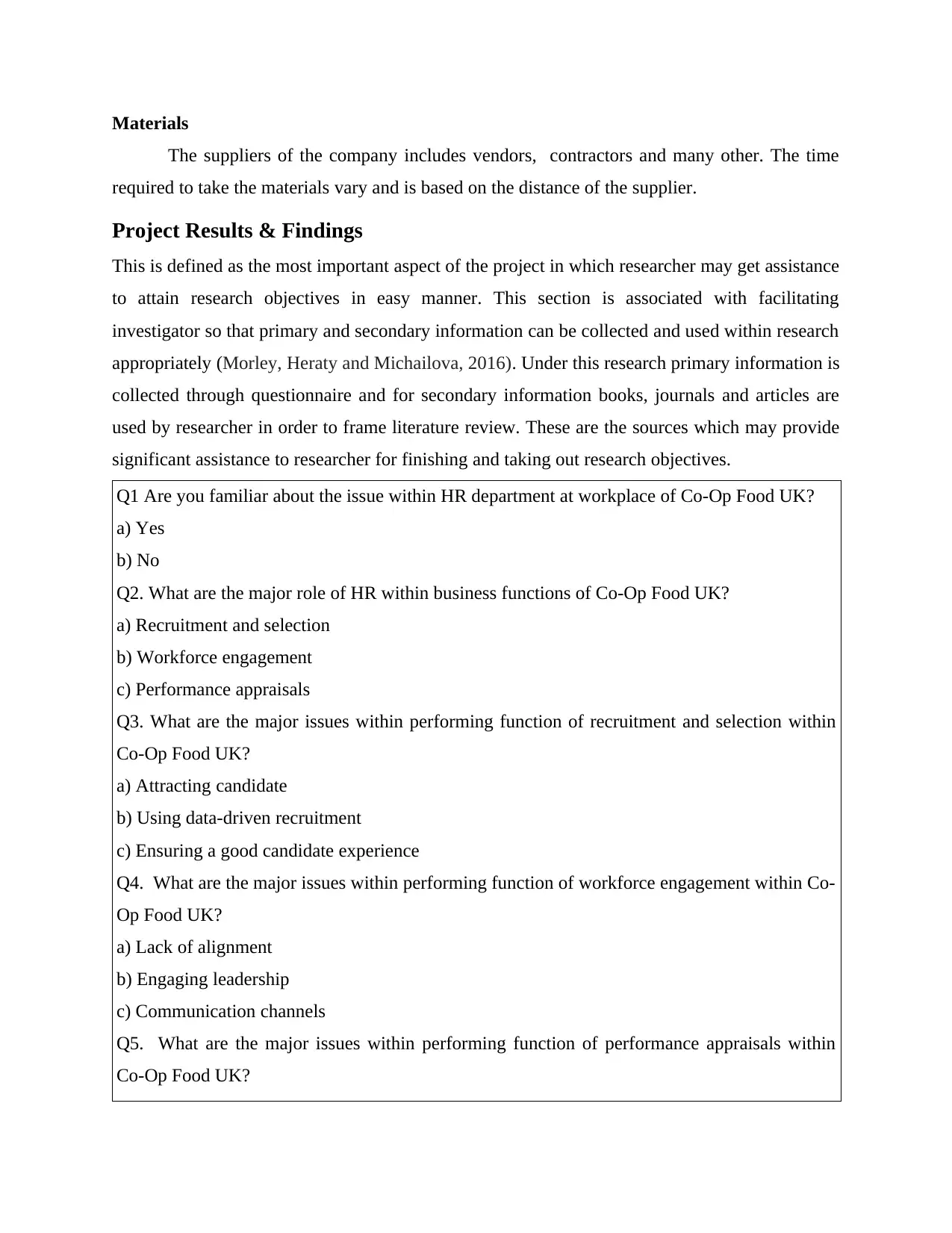
Materials
The suppliers of the company includes vendors, contractors and many other. The time
required to take the materials vary and is based on the distance of the supplier.
Project Results & Findings
This is defined as the most important aspect of the project in which researcher may get assistance
to attain research objectives in easy manner. This section is associated with facilitating
investigator so that primary and secondary information can be collected and used within research
appropriately (Morley, Heraty and Michailova, 2016). Under this research primary information is
collected through questionnaire and for secondary information books, journals and articles are
used by researcher in order to frame literature review. These are the sources which may provide
significant assistance to researcher for finishing and taking out research objectives.
Q1 Are you familiar about the issue within HR department at workplace of Co-Op Food UK?
a) Yes
b) No
Q2. What are the major role of HR within business functions of Co-Op Food UK?
a) Recruitment and selection
b) Workforce engagement
c) Performance appraisals
Q3. What are the major issues within performing function of recruitment and selection within
Co-Op Food UK?
a) Attracting candidate
b) Using data-driven recruitment
c) Ensuring a good candidate experience
Q4. What are the major issues within performing function of workforce engagement within Co-
Op Food UK?
a) Lack of alignment
b) Engaging leadership
c) Communication channels
Q5. What are the major issues within performing function of performance appraisals within
Co-Op Food UK?
The suppliers of the company includes vendors, contractors and many other. The time
required to take the materials vary and is based on the distance of the supplier.
Project Results & Findings
This is defined as the most important aspect of the project in which researcher may get assistance
to attain research objectives in easy manner. This section is associated with facilitating
investigator so that primary and secondary information can be collected and used within research
appropriately (Morley, Heraty and Michailova, 2016). Under this research primary information is
collected through questionnaire and for secondary information books, journals and articles are
used by researcher in order to frame literature review. These are the sources which may provide
significant assistance to researcher for finishing and taking out research objectives.
Q1 Are you familiar about the issue within HR department at workplace of Co-Op Food UK?
a) Yes
b) No
Q2. What are the major role of HR within business functions of Co-Op Food UK?
a) Recruitment and selection
b) Workforce engagement
c) Performance appraisals
Q3. What are the major issues within performing function of recruitment and selection within
Co-Op Food UK?
a) Attracting candidate
b) Using data-driven recruitment
c) Ensuring a good candidate experience
Q4. What are the major issues within performing function of workforce engagement within Co-
Op Food UK?
a) Lack of alignment
b) Engaging leadership
c) Communication channels
Q5. What are the major issues within performing function of performance appraisals within
Co-Op Food UK?
⊘ This is a preview!⊘
Do you want full access?
Subscribe today to unlock all pages.

Trusted by 1+ million students worldwide
1 out of 29
Related Documents
Your All-in-One AI-Powered Toolkit for Academic Success.
+13062052269
info@desklib.com
Available 24*7 on WhatsApp / Email
![[object Object]](/_next/static/media/star-bottom.7253800d.svg)
Unlock your academic potential
Copyright © 2020–2025 A2Z Services. All Rights Reserved. Developed and managed by ZUCOL.





